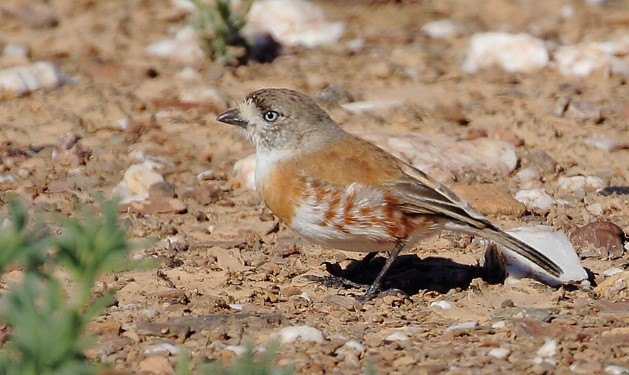Chestnut-breasted Whiteface (Aphelocephala pectoralis) belongs to the family Acanthizidae. One of Australia’s least known and most rarely seen birds, the Chestnut-breasted Whiteface has not been described until 1871. A nest and eggs were first found in 1968. Its rarity and apparent nomadism are two reasons for its existence. Around the western fringes of the Lake Eyre basin, it grows in sparse saltbush and blue bush vegetation, mixed with desert annuals, in stony, shrubbed steppes, and low tablelands.
Out of the breeding season, Chestnut-breasted Whitefaces gather in loose bands of up to 10 birds, their movements apparently determined by seasonal conditions. Taking seeds and small insects from the ground, they hop in short bursts like their larger counterparts.
The birds’ flight also resembles that of other whitefaces, with low, swift undulations that carry them to shrub cover when flushed. Sometimes they feed in mixed flocks with Banded and Southern Whitefaces. Breeding may occur if good seasons occur, though sometimes they return to the same nesting site every year if the seasons are favorable.

Chestnut-breasted Tit is another name for it. In terms of length, Chestnut-breasted Whiteface measures 110-120 mm. There is no difference between the sexes when it comes to adults. The crown is grey-brown, flecked with dusky; the rest of the upper parts are cinnamon-rufous. The wings are grey-brown with cinnamon-white edges on the secondaries and coverts. The tail is dusky with a white tip. The forehead and face are white, with a dusky line in front of the eyes separating them from the crown and ears. A chestnut band runs across the breast, and the flanks are flecked with rufous. White is the color of the eyes. Black is the color of the bill. The feet are dusky in color. IMMATURE: As an adult, the breast band is narrower and the edge is dusky. Juveniles have only fine black breastbands.
It sounds like Southern Whiteface’s erratic, staccato twittering in contact. The song is described as a soft, plaintive whistle. Breeding and nesting occur between August and September, depending on rainfall and seasonal conditions. The nest consists of a rounded, dead twig globe with a feather and wool lining along the side entrance. The only occupied nest so far described was built into a Maireana shrub 300 mm above the ground and was similar to the Banded Whiteface but without an entrance tunnel.
Chestnut-breasted Whiteface lays three eggs, which are matt pale pink, covered with purple-grey markings, especially at the larger end; oblong-oval, about 17 x 13 mm. It can be found in shrub steppe on elevated gibber-plains around Granite Downs, Oodnadatta, Lyndhurst, and Kingoonya, SA, between Granite Downs, Oodnadatta, and Lyndhurst. No races have been reported.
Read More – Jacky winter (Microeca fascinans)
